
| Version | Summary | Created by | Modification | Content Size | Created at | Operation |
|---|---|---|---|---|---|---|
| 1 | Camila Xu | -- | 2128 | 2022-10-24 01:50:44 |
Video Upload Options
Bloom's taxonomy is a set of three hierarchical models used to classify educational learning objectives into levels of complexity and specificity. The three lists cover the learning objectives in cognitive, affective and sensory domains. The cognitive domain list has been the primary focus of most traditional education and is frequently used to structure curriculum learning objectives, assessments and activities. The models were named after Benjamin Bloom, who chaired the committee of educators that devised the taxonomy. He also edited the first volume of the standard text, Taxonomy of Educational Objectives: The Classification of Educational Goals.
1. History
Although named after Bloom, the publication of Taxonomy of Educational Objectives followed a series of conferences from 1949 to 1953, which were designed to improve communication between educators on the design of curricula and examinations.[1]
The first volume of the taxonomy, Handbook I: Cognitive[2] was published in 1956, and in 1964 the second volume Handbook II: Affective was published.[3][4][5][6][7] A revised version of the taxonomy for the cognitive domain was created in 2001.[8]
2. The Cognitive Domain (Knowledge-based), Original Version
In the 1956 original version of the taxonomy, the cognitive domain is broken into the six levels of objectives listed below.[9] In the 2001 revised edition of Bloom's taxonomy, the levels have slightly different names and the order is revised: Remember, Understand, Apply, Analyze, Evaluate, and Create (rather than Synthesize).[8][10]
2.1. Knowledge
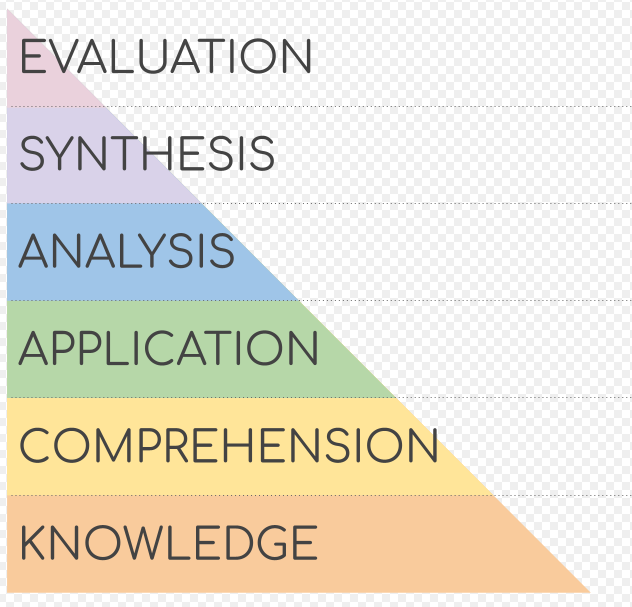
Knowledge involves recognizing or remembering facts, terms, basic concepts, or answers without necessarily understanding what they mean. Its characteristics may include:
- Knowledge of specifics—terminology, specific facts
- Knowledge of ways and means of dealing with specifics—conventions, trends and sequences, classifications and categories
- Knowledge of the universals and abstractions in a field—principles and generalizations, theories and structures
Example: Name three common varieties of apple.
2.2. Comprehension
Comprehension involves demonstrating an understanding of facts and ideas by organizing, summarizing, translating, generalizing, giving descriptions, and stating the main ideas.
Example: Summarize the identifying characteristics of a Golden Delicious apple and a Granny Smith apple.
2.3. Application
Application involves using acquired knowledge—solving problems in new situations by applying acquired knowledge, facts, techniques and rules. Learners should be able to use prior knowledge to solve problems, identify connections and relationships and how they apply in new situations.
Example: Would apples prevent scurvy, a disease caused by a deficiency in vitamin C?
2.4. Analysis
Analysis involves examining and breaking information into component parts, determining how the parts relate to one another, identifying motives or causes, making inferences, and finding evidence to support generalizations. Its characteristics include:
- Analysis of elements
- Analysis of relationships
- Analysis of organization
Example: Compare and contrast four ways of serving foods made with apples and examine which ones have the highest health benefits.
2.5. Synthesis
Synthesis involves building a structure or pattern from diverse elements; it also refers to the act of putting parts together to form a whole. Its characteristics include:
- Production of a unique communication
- Production of a plan, or proposed set of operations
- Derivation of a set of abstract relations
Example: Convert an "unhealthy" recipe for apple pie to a "healthy" recipe by replacing your choice of ingredients. Argue for the health benefits of using the ingredients you chose versus the original ones.
2.6. Evaluation
Evaluation involves presenting and defending opinions by making judgments about information, the validity of ideas, or quality of work based on a set of criteria. Its characteristics include:
- Judgments in terms of internal evidence
- Judgments in terms of external criteria
Example: Which kinds of apples are best for baking a pie, and why?
3. The Affective Domain (Emotion-Based)
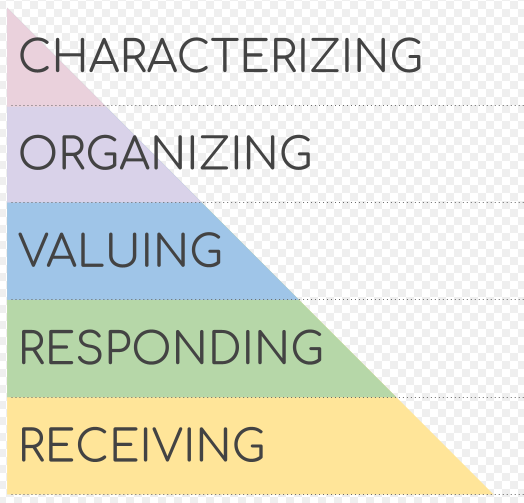
Skills in the affective domain describe the way people react emotionally and their ability to feel other living things' pain or joy. Affective objectives typically target the awareness and growth in attitudes, emotion, and feelings.
There are five levels in the affective domain moving through the lowest-order processes to the highest.
3.1. Receiving
The lowest level; the student passively pays attention. Without this level, no learning can occur. Receiving is about the student's memory and recognition as well.
3.2. Responding
The student actively participates in the learning process, not only attends to a stimulus; the student also reacts in some way.
3.3. Valuing
The student attaches a value to an object, phenomenon, or piece of information. The student associates a value or some values to the knowledge they acquired.
3.4. Organizing
The student can put together different values, information, and ideas, and can accommodate them within their own schema; the student is comparing, relating and elaborating on what has been learned.
3.5. Characterizing
The student at this level tries to build abstract knowledge.
4. The Psychomotor Domain (Action-Based)
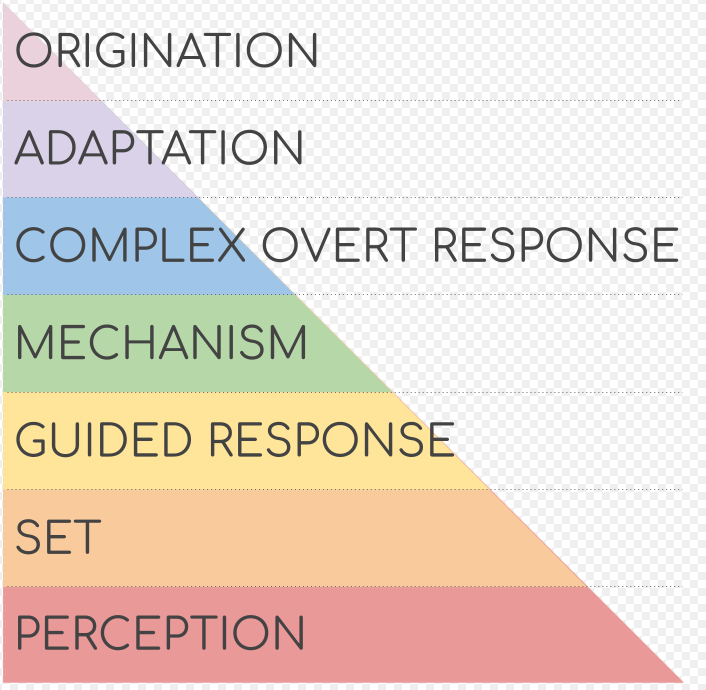
Skills in the psychomotor domain describe the ability to physically manipulate a tool or instrument like a hand or a hammer. Psychomotor objectives usually focus on change and/or development in behavior and/or skills.
Bloom and his colleagues never created subcategories for skills in the psychomotor domain, but since then other educators have created their own psychomotor taxonomies.[6] Simpson (1972)[11] proposed the following levels:
4.1. Perception
The ability to use sensory cues to guide motor activity: This ranges from sensory stimulation, through cue selection, to translation.
Examples: Detects non-verbal communication cues. Estimate where a ball will land after it is thrown and then moving to the correct location to catch the ball. Adjusts heat of the stove to correct temperature by smell and taste of food. Adjusts the height of the forks on a forklift by comparing where the forks are in relation to the pallet.
Key words: chooses, describes, detects, differentiates, distinguishes, identifies, isolates, relates, selects.
4.2. Set
Readiness to act: It includes mental, physical, and emotional sets. These three sets are dispositions that predetermine a person's response to different situations (sometimes called mindsets). This subdivision of psychomotor is closely related with the "responding to phenomena" subdivision of the affective domain.
Examples: Knows and acts upon a sequence of steps in a manufacturing process. Recognizes his or her abilities and limitations. Shows desire to learn a new process (motivation).
Keywords: begins, displays, explains, moves, proceeds, reacts, shows, states, volunteers.
4.3. Guided Response
The early stages of learning a complex skill that includes imitation and trial and error: Adequacy of performance is achieved by practicing.
Examples: Performs a mathematical equation as demonstrated. Follows instructions to build a model. Responds to hand-signals of the instructor while learning to operate a forklift.
Keywords: copies, traces, follows, reacts, reproduces, responds.
4.4. Mechanism
The intermediate stage in learning a complex skill: Learned responses have become habitual and the movements can be performed with some confidence and proficiency.
Examples: Use a personal computer. Repair a leaking tap. Drive a car.
Key words: assembles, calibrates, constructs, dismantles, displays, fastens, fixes, grinds, heats, manipulates, measures, mends, mixes, organizes, sketches.
4.5. Complex Overt Response
The skillful performance of motor acts that involve complex movement patterns: Proficiency is indicated by a quick, accurate, and highly coordinated performance, requiring a minimum of energy. This category includes performing without hesitation and automatic performance. For example, players will often utter sounds of satisfaction or expletives as soon as they hit a tennis ball or throw a football because they can tell by the feel of the act what the result will produce.
Examples: Maneuvers a car into a tight parallel parking spot. Operates a computer quickly and accurately. Displays competence while playing the piano.
Key words: assembles, builds, calibrates, constructs, dismantles, displays, fastens, fixes, grinds, heats, manipulates, measures, mends, mixes, organizes, sketches. (Note: The key words are the same as in mechanism, but will have adverbs or adjectives that indicate that the performance is quicker, better, more accurate, etc.)
4.6. Adaptation
Skills are well developed and the individual can modify movement patterns to fit special requirements.
Examples: Responds effectively to unexpected experiences. Modifies instruction to meet the needs of the learners. Performs a task with a machine that was not originally intended for that purpose (the machine is not damaged and there is no danger in performing the new task).
Key words: adapts, alters, changes, rearranges, reorganizes, revises, varies.
4.7. Origination
Creating new movement patterns to fit a particular situation or specific problem: Learning outcomes emphasize creativity based upon highly developed skills.
Examples: Constructs a new set or pattern of movements organized around a novel concept or theory. Develops a new and comprehensive training program. Creates a new gymnastic routine.
Key words: arranges, builds, combines, composes, constructs, creates, designs, initiates, makes, originates.
5. Definition of Knowledge
In the appendix to Handbook I, there is a definition of knowledge which serves as the apex for an alternative, summary classification of the educational goals. This is significant as the taxonomy has been called upon significantly in other fields such as knowledge management, potentially out of context. "Knowledge, as defined here, involves the recall of specifics and universals, the recall of methods and processes, or the recall of a pattern, structure, or setting."[12]
The taxonomy is set out as follows:
- 1.00 Knowledge
- 1.10 Knowledge of specifics
- 1.11 Knowledge of terminology
- 1.12 Knowledge of specific facts
- 1.20 Knowledge of ways and means of dealing with specifics
- 1.21 Knowledge of conventions
- 1.22 Knowledge of trends and sequences
- 1.23 Knowledge of classifications and categories
- 1.24 Knowledge of criteria
- 1.25 Knowledge of methodology
- 1.30 Knowledge of the universals and abstractions in a field
- 1.31 Knowledge of principles and generalizations
- 1.32 Knowledge of theories and structures
6. Criticism of the Taxonomy
As (Morshead 1965) pointed out on the publication of the second volume, the classification was not a properly constructed taxonomy, as it lacked a systematic rationale of construction.
This was subsequently acknowledged in the discussion of the original taxonomy in its 2001 revision,[8] and the taxonomy was reestablished on more systematic lines.
Some critiques of the taxonomy's cognitive domain admit the existence of these six categories but question the existence of a sequential, hierarchical link.[13] Often, educators view the taxonomy as a hierarchy and may mistakenly dismiss the lowest levels as unworthy of teaching.[14][15] The learning of the lower levels enables the building of skills in the higher levels of the taxonomy, and in some fields, the most important skills are in the lower levels (such as identification of species of plants and animals in the field of natural history).[14][15] Instructional scaffolding of higher-level skills from lower-level skills is an application of Vygotskian constructivism.[16][17]
Some consider the three lowest levels as hierarchically ordered, but the three higher levels as parallel.[8] Others say that it is sometimes better to move to application before introducing concepts, the goal being to create a problem-based learning environment where the real world context comes first and the theory second, to promote the student's grasp of the phenomenon, concept, or event.
The distinction between the categories can be seen as artificial since any given cognitive task may entail a number of processes. It could even be argued that any attempt to nicely categorize cognitive processes into clean, cut-and-dried classifications undermines the holistic, highly connective and interrelated nature of cognition.[18] This is a criticism that can be directed at taxonomies of mental processes in general.
The taxonomy is widely implemented as a hierarchy of verbs, designed to be used when writing learning outcomes, but a 2020 analysis showed that these verb lists showed no consistency between educational institutions, and thus learning outcomes that were mapped to one level of the hierarchy at one educational institution could be mapped to different levels at another institution.[19]
7. Implications
Bloom's taxonomy serves as the backbone of many teaching philosophies, in particular, those that lean more towards skills rather than content.[7][8] These educators view content as a vessel for teaching skills. The emphasis on higher-order thinking inherent in such philosophies is based on the top levels of the taxonomy including application, analysis, synthesis, and evaluation. Bloom's taxonomy can be used as a teaching tool to help balance evaluative and assessment-based questions in assignments, texts, and in-class engagements to ensure that all orders of thinking are exercised in students' learning, including aspects of information searching.[20]
8. Connections Across Disciplines
Bloom's taxonomy (and the revised taxonomy) continues to be a source of inspiration for educational philosophy and for developing new teaching strategies. The skill development that takes place at higher orders of thinking interacts well with a developing global focus on multiple literacies and modalities in learning and the emerging field of integrated disciplines.[21] The ability to interface with and create media would draw upon skills from both higher order thinking skills (analysis, creation, and evaluation) and lower order thinking skills (knowledge, comprehension, and application).[22][23]
9. Visual Interpretations
Bloom's original taxonomy may not have included verbs or visual representations, but subsequent contributions to the idea have portrayed the ideas visually for researchers, teachers and students.
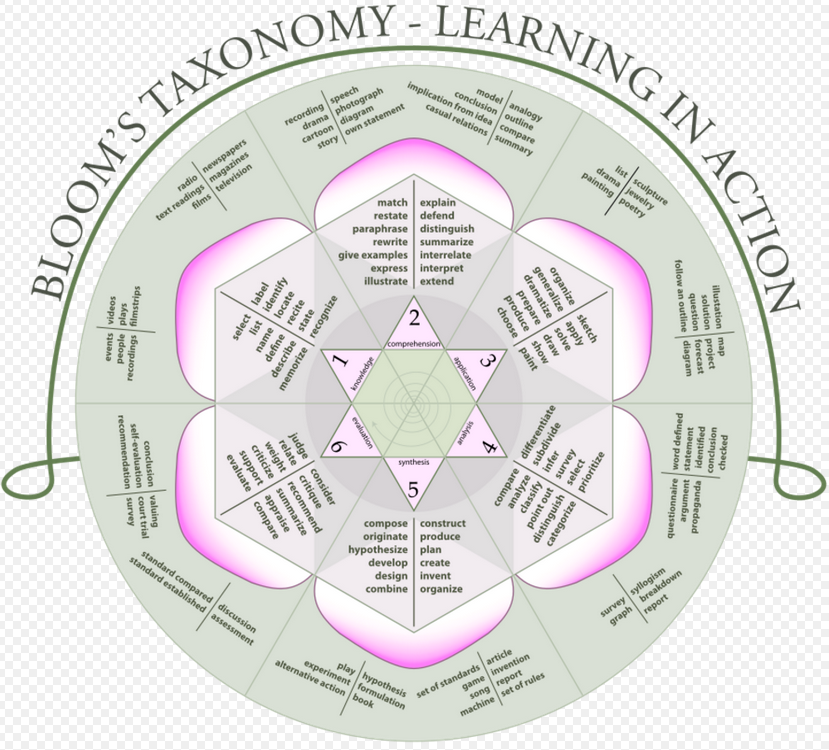
Bloom's taxonomy organized radially
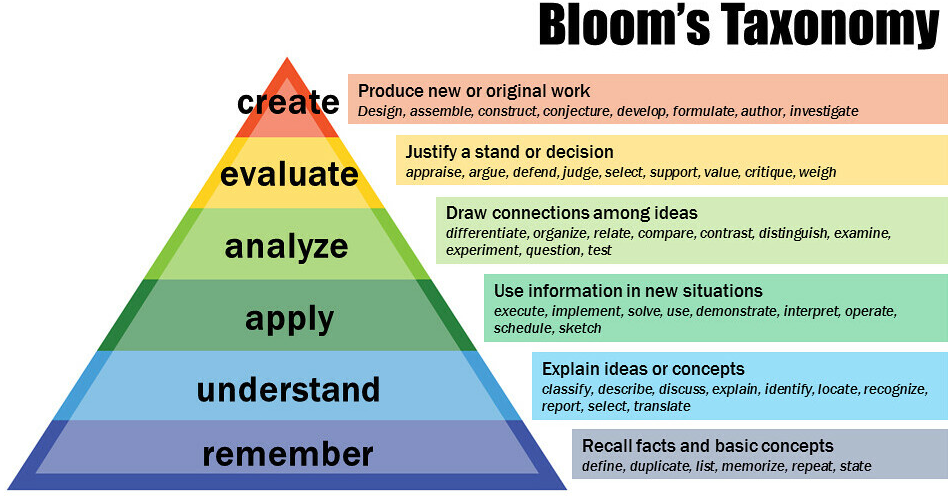
Bloom's revised taxonomy organized as a pyramid of learning levels with explanations of each
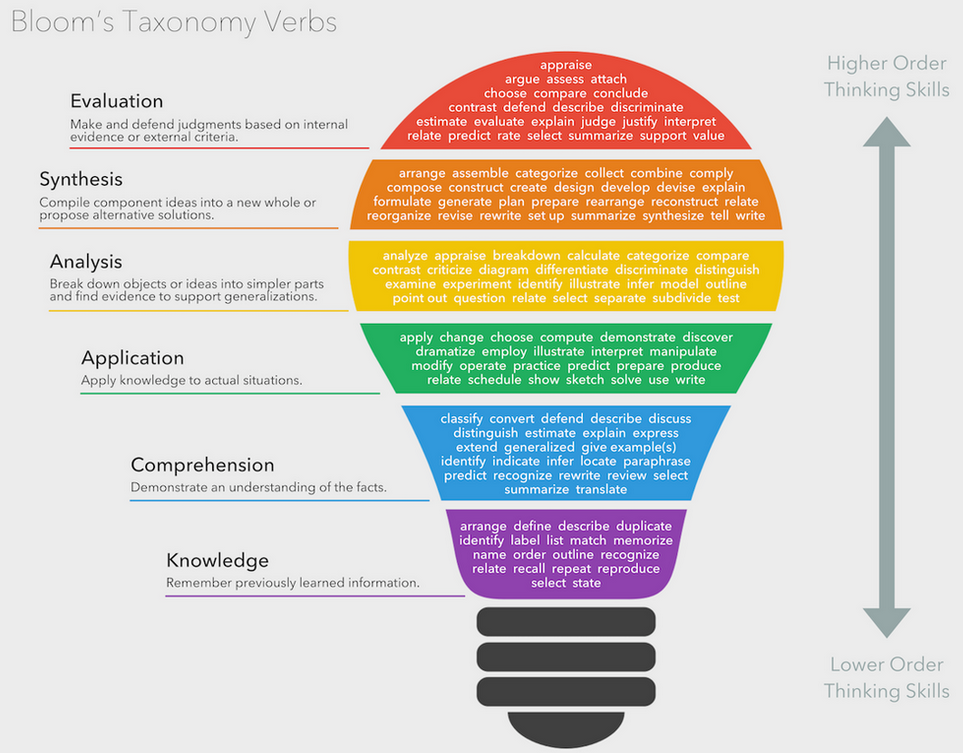
Bloom's taxonomy verbs portrayed as a light bulb

Bloom's cognitive domain organized as an inverted pyramid
References
- Bloom et al. 1956, p. 4: "The idea for this classification system was formed at an informal meeting of college examiners attending the 1948 American Psychological Association Convention in Boston. At this meeting, interest was expressed in a theoretical framework which could be used to facilitate communication among examiners.
- Bloom, B. S.; Engelhart, M. D.; Furst, E. J.; Hill, W. H.; Krathwohl, D. R. (1956). Taxonomy of educational objectives: The classification of educational goals. Handbook I: Cognitive domain. New York: David McKay Company.
- Simpson, Elizabeth J. (1966). "The classification of educational objectives: Psychomotor domain". Illinois Journal of Home Economics 10 (4): 110–144.
- *Harrow, Anita J. (1972). A taxonomy of the psychomotor domain: A guide for developing behavioral objectives. New York: David McKay Company.
- *Dave, R. H. (1975). Armstrong, R. J.. ed. Developing and writing behavioral objectives. Tucson: Educational Innovators Press.
- Clark, Donald R. (1999). "Bloom's Taxonomy of Learning Domains". http://www.nwlink.com/~donclark/hrd/bloom.html.
- Krathwohl, David R. (2002). "A revision of Bloom's taxonomy: An overview". Theory into Practice (Routledge) 41 (4): 212–218. doi:10.1207/s15430421tip4104_2. ISSN 0040-5841. https://dx.doi.org/10.1207%2Fs15430421tip4104_2
- A taxonomy for learning, teaching, and assessing: A revision of Bloom's taxonomy of educational objectives. New York: Longman.. 2001. ISBN 978-0-8013-1903-7.
- Hoy, Anita Woolfolk (2007). Educational psychology (10th ed.). Boston: Pearson/Allyn and Bacon. pp. 530–531, 545. ISBN 978-0205459469. OCLC 68694368. http://www.worldcat.org/oclc/68694368
- Armstrong, Patricia (2010-06-10). "Bloom's Taxonomy". Vanderbilt University. https://cft.vanderbilt.edu/guides-sub-pages/blooms-taxonomy/.
- Simpson, Elizabeth (1972). Educational objectives in the psychomotor domain. 3. Washington, D.C.: Gryphon House. pp. 25–30. https://files.eric.ed.gov/fulltext/ED010368.pdf. Retrieved 3 April 2018.
- Bloom et al. 1956, p. 201.
- Paul, R. (1993). Critical thinking: what every person needs to survive in a rapidly changing world (3rd ed.). Rohnert Park, California: Sonoma State University Press.
- Flannery, Maura C. (November 2007). "Observations on biology". The American Biology Teacher 69 (9): 561–564. doi:10.1662/0002-7685(2007)69[561:OOB2.0.CO;2]. https://www.nabt.org/websites/institution/File/pdfs/american_biology_teacher/2007/069-09-0561.pdf. Retrieved 2017-03-05. "Biology is often referred to as an observational science almost as a slur, with the implication that biologists simply look at the living world without the strong theoretical and mathematic underpinnings of a science like physics. There is the suggestion that observation is easy. Thus biology is viewed as a lightweight science—anyone can do it: just go out and start looking, at birds, at grass, at cells under the microscope. Benjamin Bloom's taxonomy of learning tasks puts observation at the lowest level, with recall of information. This denigration of observation has long bothered me because I see it as often difficult and complex, a skill that needs to be learned and a talent that is much more developed in some.".
- Lawler, Susan (26 February 2016). "Identification of animals and plants is an essential skill set". The Conversation. https://theconversation.com/identification-of-animals-and-plants-is-an-essential-skill-set-55450. "Ironically, the dogma that has been so detrimental to field taxonomy is known as Bloom's taxonomy. University lecturers are told to apply an educational theory developed by Benjamin Bloom, which categorises assessment tasks and learning activities into cognitive domains. In Bloom's taxonomy, identifying and naming are at the lowest level of cognitive skills and have been systematically excluded from University degrees because they are considered simplistic."
- Vygotsky, L. S. (1978). "Chapter 6: Interaction between learning and development". Mind in society: the development of higher psychological processes. Cambridge, Massachusetts: Harvard University Press. pp. 79–91.
- Keene, Judith; Colvin, John; Sissons, Justine (June 2010). "Mapping student information literacy activity against Bloom's taxonomy of cognitive skills". Journal of Information Literacy 4 (1): 6–21. doi:10.11645/4.1.189. http://jil.lboro.ac.uk/ojs/index.php/JIL/article/view/PRA-V4-I1-2010-1. "When supporting students outside the classroom situation, a subject aware advisor should be capable of spotting mistakes in a student's solution and of analysing these mistakes to identify the difficulty that the student is encountering. Such support can be seen as offering scaffolding in a student's 'zone of proximal development' (Vygotsky, 1978) and exemplified by teaching students to analyse a problem through the identification of the key elements and the relationships between these elements.".
- Fadul, J. A. (2009). "Collective Learning: Applying distributed cognition for collective intelligence". The International Journal of Learning 16 (4): 211–220. doi:10.18848/1447-9494/CGP/v16i04/46223. ISSN 1447-9494. https://dx.doi.org/10.18848%2F1447-9494%2FCGP%2Fv16i04%2F46223
- Newton, Philip M.; Da Silva, Ana; Peters, Lee George (10 July 2020). "A pragmatic master list of action verbs for Bloom's taxonomy". Frontiers in Education 5. doi:10.3389/feduc.2020.00107. https://dx.doi.org/10.3389%2Ffeduc.2020.00107
- BJ Jansen, D Booth, B Smith (2009) Using the taxonomy of cognitive learning to model online searching, Information Processing & Management 45 (6), 643-663 https://faculty.ist.psu.edu/jjansen/academic/pubs/jansen_using_the_taxonomy_of_cognitive_learning_to_model_online_searching.pdf
- Kress, G.; Selander, S. (2012). "Multimodal design, learning and cultures of recognition". Internet and Higher Education 15 (1): 265–268. doi:10.1016/j.iheduc.2011.12.003. https://dx.doi.org/10.1016%2Fj.iheduc.2011.12.003
- Paul, R.; Elder, L. (2004). Critical and creative thinking. Dillon Beach, CA: The Foundation for Critical Thinking.
- The New London Group (1996). A pedagogy of multiliteracies: designing social futures. Harvard Educational Review.




